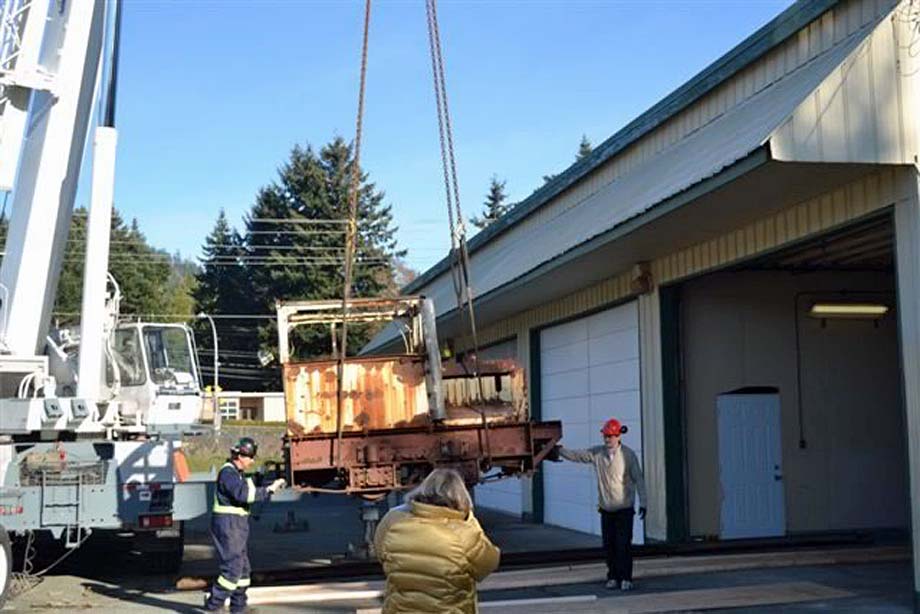The Jordan River railway was built in 1909 by the Vancouver Island Power Company, a subsidiary of BC Electric Railway Company Ltd. when construction began on a dam and powerhouse.
It was around 9 kilometres in length and ran alongside a flume from the Forebay Reservoir to the Diversion Dam 1,150 feet above sea level.
A narrow gauge railway of 3 feet, this type of railway was common for industrial enterprises of the area, as they were less costly to build than a standard track.
Various steam, gas locomotives, and speeders served the railway until 1940 when the 1928 Plymouth gasoline locomotive with a 32 HP Le Roi Engine arrived from the Goldstream Power Station to serve the busy operation.
This engine has a multiple speed gear system, for the locomotive to navigate mountainous terrain like the Jordan River hillside.
It was replaced with a Ford Flathead engine likely around the late 1930-1940s.
The Dam
The Vancouver Island Power Company's hydro electric plant opened 10 Sep 1911 on the beach near the mouth of the Jordan River, supplying power to Victoria and the lower Island area.
It was a major project led by the Superintendent for the Company, the legendary D.I. Walker.
From the artificial Forebay Reservoir, located 1,150 feet above the powerhouse, four penstocks carried rushing water down to the turbines.
The Forebay Reservoir was linked to the engineering feats of the Diversion Dam and Reservoir, further up the river, through a wooden flume 8.5 kilometres in length, alongside of which ran the railway.
The line, which ran all the way into Victoria, transported the power, supported by cedar poles.
At the height of construction the operation employed more than a thousand workers, and a bustling community developed, with sports facilities and an orchestra.
The flume and railway operated from 1913 to 1971, when a new powerhouse was opened at Jordan River.
In 1927 the wooden aqueduct was mostly rebuilt and was intact until the 1980s.
By the 1970s the rail system had been long out of service and was to be dismantled and scrapped.
The Vancouver Island Production Manager at that time sought a way to preserve the locomotives and track.
With the Mayor of Nanaimo's assistance, they devised a plan to install them as a tourist attraction on Newcastle Island in the Nanaimo Harbour.
Arrangements were made to ship the locomotives to Nanaimo where they could by refurbished.
However, before the initiative could get underway, the Provincial Government declared Newcastle Island as a Provincial Park, eliminating the possibility of fulfilling the dream of a narrow gauge railway tourist attraction.
Arrangements were then made to store the two locomotives at the BC Forest Discovery Centre in North Cowichan.
There were a few unsuccessful attempts to have them restored and suitably placed for public viewing.
The engines remained at the Centre until their relocation on 21 Nov 2013 to the Kaltasin works yard in Sooke.
The move was initiated by Ted Olnyk of BC Hydro, who thought Sooke to be a better suited home for them, one closer to their original place of use.
He contacted Bonnie Sprinkling, the District of Sooke's Corporate Officer, who then turned over the project to Director Lee Boyko at the Sooke Region Museum.
B.C. Hydro donated the engines and $5,000 towards their restoration at the Sooke Region Museum.
On hand for the transport were museum members and Karla Louwers from BC Hydro.
The intention was to have the engines non-operationally restored, have one displayed on the museum grounds, and the other in Jordan River.
Brian Sorokan from RKM Crane Service provided a crane-lift truck that would lift the cars and maneuver them into the repair bay at the works yard.
Museum Lead Hand Willy Webb and a team of several volunteers then got to work on refurbishing the engines at the works yard, a space provided by the District of Sooke, until 2019 when Vic City Crane Ltd. transported the engines and 4M Bobcat and Trucking Ltd. prepared the site.
After completion of the restoration, the 1928 Plymouth engine was moved to its new permanent home across from the Museum's service building on 2 Jun 2019.
Guy LeDrew, with the help of his sister Noella, the museum's caretaker, built a sturdy shelter to help the locomotive withstand the elements.
Noella also designed an interpretive panel for the new artifact, printed by Tran Sign.
Clifford D. Banner, the author of "Power Pioneer", who worked at Jordan River 1949-1982, said of the project, "The BC Hydro Power Pioneers sincerely appreciate that these two legacy icons will serve to enlighten future generations. The Power Pioneers sincerely appreciate and wish to thank the BC Forest Discovery Centre, the BC Hydro managers, who both originally conceived the restoration, and then facilitated the arrangements, and finally the Sooke Region Museum for enabling it to happen."
Author unknown.
 A copy of the un-published book named "Power Pioneer" may be found at the Sooke Region Musuem.
A copy of the un-published book named "Power Pioneer" may be found at the Sooke Region Musuem.(likely no image with original article)
(usually because it's been seen before)
provisions in Section 29 of the
Canadian Copyright Modernization Act.


